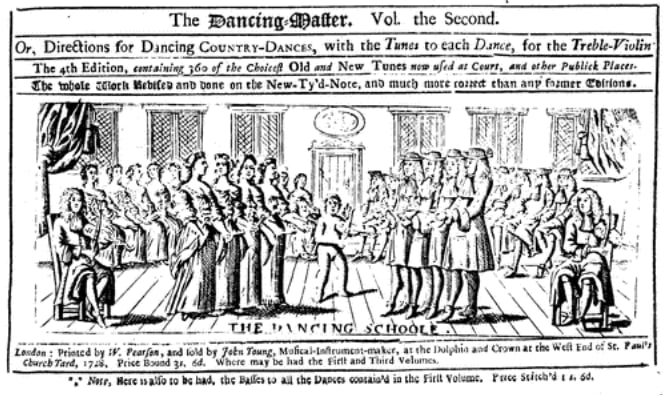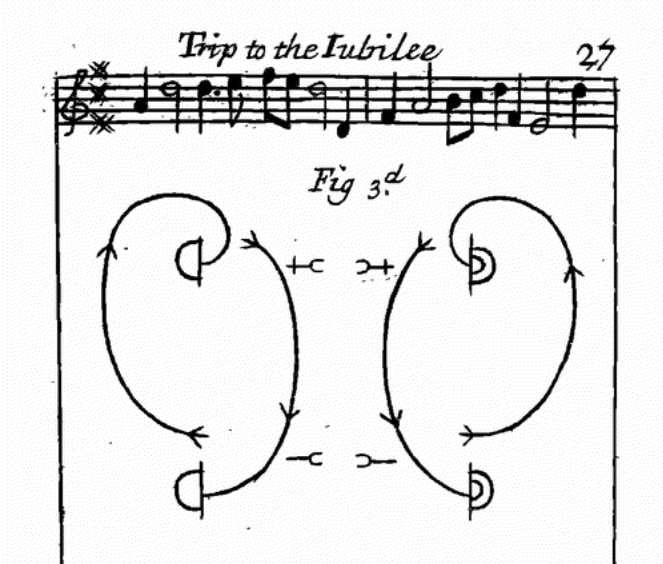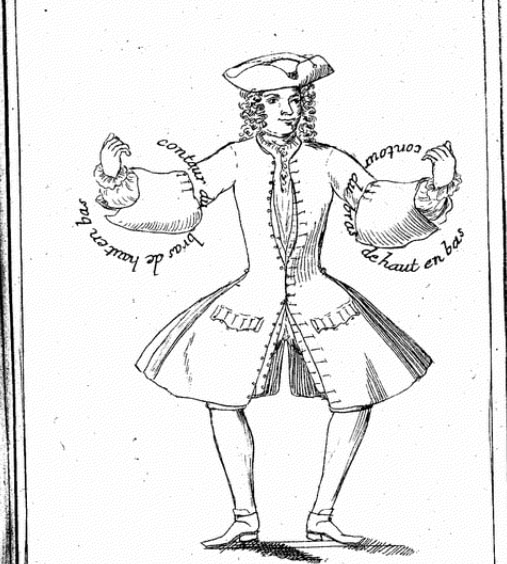Greetings, Dance Students! We know you have been working hard on your honors from the last installment; be sure to continue practicing those as we move through the series. Today we will focus on the structure of one of the main styles of 18th-century English Country Dancing: Two-Couple Dances. We have touched on these lightly in a previous post, but this lesson will focus more closely on how this style of dance looks, moves, and progresses on the floor. Beginners often find these elements to be the most mysterious, or even intimidating part of country dancing, but we think you’ll see how the moving parts are all actually very simple! So, without further adieu, let’s jump right in:

As the name implies, two-couple dances are dances for… two couples! See? I told you this was easy. If you’ll take a look at the above image, however, you’ll notice that there are actually four couples on the floor. That’s because these are longways dances, often paired with the phrasing, “for as many as will.” So while there are only two couples (a total of four people) in a single set, there can be as many sets on the floor, all situated in long lines as seen above, with the gentlemen on one side, and ladies on the other. At the beginning of the instruction, the Dancing Master or Mistress will call for everyone to, “Take hands-four from the top,” meaning to take hands with your set of two couples; this is done to show with whom you will be dancing the first time through the dance. Yes, that’s going to change.
Two couple longways dances are often referred to as, “progressive dances.” This is because couples will change partners throughout the dance, progressing up and down the set, so they eventually have the opportunity to dance with every other couple. How do you know who to dance with? How do you even know who you are? Let’s take a look at the following image:

In the image above, Monsieur Fueillet shows us couples numbered 1, 2, 3, and 4. These four couples comprise two sets, A and B. In set A, the couple that is closest to the top of the lines (in this case, the top of the page), is couple number 1, and the couple farther from the top of the set is number 2. To keep things simple, let’s say the same thing is true for set B: Couple 1 is closer to the top, and Couple 2 is closer to the bottom. Even though the image only shows two sets, there could be three, four, five, or, “as many as will.” Each of these sets would have a Couple 1 at the top and 2 at the bottom. These numbers tell us how to move in the dance, so it’s necessary to understand who you are in the set.
We’re not going to get too far into the steps or figures of dances just yet, but it is important to know that in progressive dances, there comes a time for couple 1 in each set to advance to the second place, changing places with their couple 2. In many dances, this is accomplished by a figure known as a cast. We will talk about the cast in further detail in an upcoming blog, but suffice to say couple 1 will loop around on their own side (gentlemen on their own side, ladies on theirs), and take the second place, while couple 2 steps up into first place.

Of course, a cast will not necessarily be the final figure of the dance, but Couples 1 and 2 will finish the dance in their new places. What happens then? Why, you turn to your new partners and begin the dance again!
After one time through the dance, you’ll notice both Couples 1 and 2 have advanced in the set; Couple 1 has moved one place down the set, and Couple 2 has moved one place up the set. Now, here’s the tricky part: After the first time through the dance, the number 1 couples are still number 1 couples, the number 2 couples are still number 2s. The difference now is that each #1 couple will look down the set to find their new #2 couple, and each #2 couple will look up the set to find their new #1. This will happen as many times as the music for the dance will play, which, according to tradition, is twice the number of couples upon the floor. That means each couple will have the opportunity to dance all the way down the set as a couple 1, and all the way back up as a couple 2.
Sound confusing? Let us give you a helpful tip: If you are a 1st couple, you will be a 1st couple all the way down the set. If you are a 2nd couple, you will be a 2nd couple, all the way up the set. The only time your number changes is at the end of the set. Here’s how that works: You will arrive at the end of the set and see there is not couple 2 down the set (if you have been dancing as a couple 1), or you will see there is not a couple 1 up the set (you have have been dancing as a 2). At this point, you will remain in your place at the end of the set for one time through the dance. Take this opportunity to catch your breath (read: gossip about the other couples), because as soon as the dance begins again, you will return as the opposite number you were before. If you started as couple 1, you will be out one time through, then return as couple 2, and vice versa.
We realize this might seem like a lot to take in, but as soon as you give it a try, we think you’ll see exactly what we mean. In no time, you’ll be on the floor wowing veteran and novice dancers with your sweet moves, just like this fellow from Piere Rameau’s 1748 dancing manual:

Thanks for reading, and happy dancing!
-Katharine and Robert
Katharine Pittman is a Nation Builder for the Colonial Williamsburg Foundation researching and portraying Martha Washington. Her love of history started young as her parents brought her and her brother to CW with frequency as children, grew while getting her degree from Wake Forest University in history and theatre, and cemented in her almost 9 years with the Foundation. Outside of the 18th century, Katharine enjoys spending time with her family, watching Outlander with her girlfriends and drinking massive quantities of coffee.
Robert Weathers has been working as a first-person interpreter at Colonial Williamsburg since January 2008 and portrays Nation Builder George Wythe. When he is not in breeches, he can often be found wearing shorts no matter the weather, and riding roller coasters with his wife Kaitlyn.
